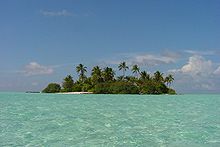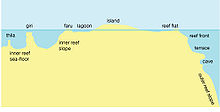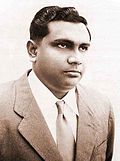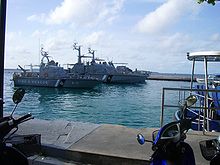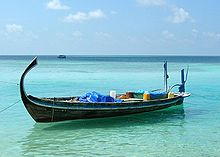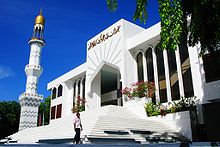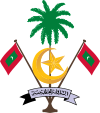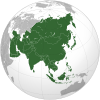- Maldives
-
Republic of Maldives ދިވެހިރާއްޖޭގެ ޖުމްހޫރިއްޔާ
(Dhivehi Raa'jeyge Jumhooriyya)

Flag Emblem Anthem: Qaumii salaam
"National Salute"
Capital Malé
4°17′N 73°50′E / 4.283°N 73.833°EOfficial language(s) Dhivehi, English Ethnic groups ≈100% Dhivehis [1][2][3] (Excluding Foreigners) Demonym Maldivian Government Presidential republic - President Mohamed Nasheed - Vice President Dr. Mohamed Waheed Hassan - Speaker of the Majlis Abdulla Shahid - Chief Justice Ahmed Faiz[4] Independence - from United Kingdom 26 July 1965 Area - Total 298 km2 (206th)
115 sq mi- Water (%) ≈100% (land negligible) Population - 2010 estimate 313,920[5] (175th1) - 2006 census 298,968[6] - Density 1,036.9/km2 (11th)
2,866.9/sq miGDP (PPP) 2011 estimate - Total $2.931 billion[7] - Per capita $9,005[7] (87th) GDP (nominal) 2011 estimate - Total $2.062 billion[7] - Per capita $6,336[7] HDI (2010)  0.602[8] (medium) (107th)
0.602[8] (medium) (107th)Currency Maldivian Rufiyaa ( MVR)Time zone (UTC+5) Drives on the left ISO 3166 code MV Internet TLD .mv Calling code 960 The Maldives (
 i/ˈmɒldaɪvz/ or /ˈmɒldiːvz/), (Dhivehi: ދިވެހިރާއްޖެ, Dhivehi Raa'je), officially Republic of Maldives (Dhivehi: ދިވެހިރާއްޖޭގެ ޖުމްހޫރިއްޔާ, Dhivehi Raa'jeyge Jumhooriyya), also referred to as the Maldive Islands, is an island nation in the Indian Ocean formed by a double chain of twenty-six atolls oriented north-south off India's Lakshadweep islands, between Minicoy Island and Chagos Archipelago. It stands in the Laccadive Sea, about 700 kilometres (430 mi) south-west of Sri Lanka and 400 kilometres (250 mi) south-west of India. During the colonial era, the Dutch referred to the country as "Maldivische Eilanden" in their documentation, while "Maldive Islands" is the anglicised version of the local name used by the British, which later came to be written "Maldives".
i/ˈmɒldaɪvz/ or /ˈmɒldiːvz/), (Dhivehi: ދިވެހިރާއްޖެ, Dhivehi Raa'je), officially Republic of Maldives (Dhivehi: ދިވެހިރާއްޖޭގެ ޖުމްހޫރިއްޔާ, Dhivehi Raa'jeyge Jumhooriyya), also referred to as the Maldive Islands, is an island nation in the Indian Ocean formed by a double chain of twenty-six atolls oriented north-south off India's Lakshadweep islands, between Minicoy Island and Chagos Archipelago. It stands in the Laccadive Sea, about 700 kilometres (430 mi) south-west of Sri Lanka and 400 kilometres (250 mi) south-west of India. During the colonial era, the Dutch referred to the country as "Maldivische Eilanden" in their documentation, while "Maldive Islands" is the anglicised version of the local name used by the British, which later came to be written "Maldives".The archipelago is located on top of the Chagos-Maldives-Laccadive Ridge a vast submarine mountain range in the Indian Ocean.[9] The Maldives also form a terrestrial ecoregion together with the Chagos and the Lakshadweep.[10] The atolls of the Maldives encompass a territory spread over roughly 90,000 square kilometres (35,000 sq mi), making it one of the world's most dispersed countries in geographic terms. Its population of 313,920 (2010) inhabits 200 of its 1,192 islands.[11] Maldives' capital and largest city Malé has a population of 103,693 (2006).[5][12] It is located at the southern edge of North Malé Atoll, in the Kaafu Atoll. It is also one of the Administrative divisions of the Maldives. Traditionally it was the King's Island where the ancient Maldive Royal dynasties were enthroned.
The Maldives is the smallest Asian country in both population and land area. With an average ground level of 1.5 metres (4 ft 11 in) above sea level, it is the planet's lowest country.[13] It is also the country with the lowest highest point in the world, at 2.3 metres (7 ft 7 in);[13] the Maldives' forecast inundation is a great concern for the Maldivian people.
Contents
Etymology
See also: Names of MaldivesThe name Maldives may derive from Mahal'deeb, and the people were called Maldivian 'Dhivehin'. The word Dheeb/Deeb (archaic Dhivehi, related to Sanskrit dvīp (द्वीप)) means "island", and Dhives (Dhivehin) means "islanders" (in other words, the Maldivians). During the colonial era, the Dutch referred to the country as Maldivische Eilanden in their documentation, while Maldive Islands is the anglicised version of the local name used by the British, which later came to be written as "Maldives".[citation needed]
The ancient Sri Lankan chronicle, The Mahawamsa, refers to an island called Mahiladiva ("Island of Women", महिलादिभ) in Pali, which is probably a mistranslation of the same Sanskrit word meaning "garland". The Mahawamsa is derived from an even older Sinhala word dating back to the 2nd century BC.[citation needed]
Some theorise that the name Maldives derives from the Sanskrit mālādvīpa (मालाद्वीप), meaning "garland of islands". In Malayalam "Garland of Islands" can be translated into "Maladhweepu" (മാലിദ്വീപ്). In Tamil "Garland of Islands" can be translated into "MalaiTheevu" (மாலைத்தீவு).[14] None of the names are mentioned in any literature, but classical Sanskrit texts dating back to the Vedic times mention the "Hundred Thousand Islands" (Lakshadweepa), a generic name which would include not only the Maldives, but also the Laccadives, Aminidivi Islands, Minicoy and the Chagos island groups.[15]
Some medieval travelers such as Ibn Batuta called the islands "Mahal Dibiyat" (محل دبيأت) from the Arabic word Mahal ("palace"), which must be what the Berber traveler interpreted of the local name having been through Muslim North India, where Perso-Arabic words were introduced into the local vocabulary .[16] This is the name currently inscribed in the scroll of the Maldive state emblem. The classical Persian/Arabic name for Maldives is Dibajat.[17][18]
The name Maldives also might have come from the Sinhalese word මාල දිවයින Maala Divaina ("Necklace Islands"), perhaps referring to the shape of the archipelago.[citation needed]
Geography
Main article: Geography of the MaldivesSee also: Atolls of the Maldives and List of islands of the Maldives Malhosmadulhu Atoll seen from space. "Fasdutere" and Southern Maalhosmadulhu Atoll can be seen in this picture.
Malhosmadulhu Atoll seen from space. "Fasdutere" and Southern Maalhosmadulhu Atoll can be seen in this picture.
The Maldives consists of approximately 1,190 coral islands grouped in a double chain of 26 atolls, along the north-south direction, spread over roughly 90,000 square kilometres (35,000 sq mi), making this one of the world's most dispersed countries. It lies between latitudes 1°S and 8°N, and longitudes 72° and 74°E. The atolls are composed of live coral reefs and sand bars, situated atop a submarine ridge 960 kilometres (600 mi) long that rises abruptly from the depths of the Indian Ocean and runs north to south. Only near the southern end of this natural coral barricade do two open passages permit safe ship navigation from one side of the Indian Ocean to the other through the territorial waters of Maldives. For administrative purposes the Maldivian government organized these atolls into twenty one administrative divisions. The largest island of Maldives is Gan, which belongs to Laamu Atoll or Hahdhummathi Maldives. In Addu Atoll the westernmost islands are connected by roads over the reef (collectively called Link Road) and the total length of the road is 14 km (9 mi).
The Maldives is the lowest country in the world, with a maximum natural ground level of only 2.3 metres (7 ft 7 in), with the average being only 1.5 metres (4 ft 11 in) above sea level, although in areas where construction exists, this has been increased to several metres. More than 80 per cent of the country's land, composed of coral islands are less than one metre above sea level.[19]
The reef is composed of coral debris and living coral. This acts as a natural barrier against the sea, forming lagoons. Other islands, set at a distance and parallel to the reef, have their own protective fringe of reef. An opening in the surrounding coral barrier allows access to the calmer lagoon waters. The barrier reefs of the islands protect them from the storms and high waves of the Indian Ocean.[citation needed]
A 15 centimetres (6 in) thick layer of humus forms the top layer of soil. Below the humus layer are 60 centimetres (2 ft) of sandstone, followed by sand and then fresh water. Due to high levels of salt in the soil near the beach, vegetation is limited there to a few plants such as shrubs, flowering plants, and small hedges. In the interior of the islands, more vegetation such as mangrove and banyan grow. Coconut palms, the national tree, are able to grow almost everywhere on the islands and are integral to the lifestyle of the population.[citation needed]
The limited vegetation and land wildlife is supplemented by the abundance of marine life. The waters around the Maldives are abundant in rare species of biological and commercial value. Tuna fisheries are one of the main commercial resources. The Maldives have an amazing diversity of sea life, with corals and over 2,000 species of fish, ranging from reef fish to reef sharks, moray eels, and a wide variety of rays: Manta rays, Stingray and Eagle ray. The Maldivian waters also host whale sharks and hawksbill and green turtless.[citation needed]
Climate
The Indian Ocean acts as a heat buffer, absorbing, storing, and slowly releasing the tropical heat. The temperature of Maldives ranges between 24 °C (75 °F) and 33 °C (91 °F) throughout the year. Although the humidity is relatively high, the constant cool sea breezes keep the air moving and the heat mitigated.[citation needed]
The weather in the Maldives is affected by the large landmass of South Asia to the north. The presence of this landmass causes differential heating of land and water. These factors set off a rush of moisture-rich air from the Indian Ocean over South Asia, resulting in the southwest monsoon. Two seasons dominate Maldives' weather: the dry season associated with the winter northeastern monsoon and the rainy season which brings strong winds and storms. The shift from the moist southwest monsoon to the dry northeast monsoon occurs during April and May. During this period, the northeast winds contribute to the formation of the northeast monsoon, which reaches Maldives in the beginning of June and lasts until the end of August. However, the weather patterns of Maldives do not always conform to the monsoon patterns of South Asia. The annual rainfall averages 254 centimetres (100 in) in the north and 381 centimetres (150 in) in the south.[20]
Environmental Issues
Main article: Climate change in MaldivesOver the last century, sea levels have risen about 20 centimetres (8 in);[21][22] further rises of the ocean could threaten its existence, with a maximum natural ground level of only 2.3 metres (7 ft 7 in), averaging only 1.5 metres (4 ft 11 in) above sea level. Current estimates place sea level rise at 59 centimetres (23 in) by the year 2100. However, around 1970, the sea level there dropped 20–30 centimetres (8–12 in).[23] In November 2008, President Mohamed Nasheed announced plans to look into purchasing new land in India, Sri Lanka, and Australia because of his concerns about global warming and the possibility of much of the islands being inundated with water from rising sea levels. The purchase of land will be made from a fund generated by tourism.[24] The President has explained his intentions:
"We do not want to leave the Maldives, but we also do not want to be climate refugees living in tents for decades".[25]
On 22 April 2008, then President Maumoon Abdul Gayoom pleaded for a cut in global greenhouse gas emissions, warning that rising sea levels could submerge the island nation of the Maldives.[26][27]
By 2020 the Maldives plans to eliminate or offset all of its greenhouse gas emissions. At the 2009 International Climate Talks, President Mohamed Nasheed explained that:
“For us swearing off fossil fuels is not only the right thing to do, it is in our economic self-interest… Pioneering countries will free themselves from the unpredictable price of foreign oil; they will capitalize on the new green economy of the future, and they will enhance their moral standing giving them greater political influence on the world stage.”[28]Marine ecosystem
Maldives waters are home to several ecosystems, but are most noted for their variety of colorful coral reefs, home to 300 species of fish. Seven marine species have been described as new to science, while several more await description. Over 400 have been identified and catalogued and many are now held in the reference collection, including 5 species of sea turtles, 51 species of echinoderms, 5 species of sea grasses and 285 species of alga & sponges, crustaceans, and tunicates. About 200 coral species have been recorded to date, representing over 60 genera.[29]
Among the many marine families represented are Pufferfish, Fusiliers, Jackfish, Lionfish, Oriental Sweetlips, reef sharks, Groupers, Eels and Snappers. Bannerfish, Batfish, Humphead Wrasse, Spotted Eagle Rays, Scorpionfish, Lobsters, Nudibranches, Angelfish, Butterflyfish, Squirrelfish, Soldierfish, Glassfish, Surgeonfish, Unicornfish, Triggerfish, Napoleon wrasses and Barracudas.[30]
These coral reefs are home to a variety of marine ecosystems that vary from planktonic organisms to whale sharks. Sponges have gained importance as five species have displayed anti-tumor and anti-cancer properties.[29]
1998 El Niño
In 1998, warming due to the El Niño phenomenon killed 2/3 of the nation's coral reefs due to bleaching.[31] Coral reef bleaching is a "term suggested in place of "coral bleaching" because this condition is seldom limited to corals and most affected photo symbiotic hosts reside on coral reefs". Bleaching is the loss of photo symbiotic microorganisms (dinoflagellates, red and green algae, or cyanobacteria), or the pigments of these photosymbionts, or some of both, from tissues of host cnidarians, sponges, molluscs or other photosymbiotic host animals. The name comes from the whitening of many hosts which possess few pigments of their own.[32]
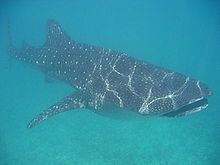 A whale shark in the Maldives, one of many animals that inhabit the reefs that make up the whole country
A whale shark in the Maldives, one of many animals that inhabit the reefs that make up the whole country
The water temperature had been raised as much as 5 °C (9.00 °F) degrees. Several scientists placed electrified cones anywhere from 20–60 feet (6.1–18 m) below the surface. The cones created an attraction for coral larva to attach itself. In 2004, scientists witnessed corals regenerating. Corals began to eject pink-orange eggs and sperm. The growth of these electrified corals was five times faster than ordinary corals.[31] Scientist Azeez Hakim stated, "before 1998, we never thought that this reef would die. We had always taken for granted that these animals would be there, that this reef would be there forever. El Niño gave us a wake-up call that these things are not going to be there forever....They help by removing and recycling the carbon-dioxide which in excess amounts can lead to global warming. Not only this, they also act as a natural barrier against the tropical storms, floods and tsunamis. Seaweeds grow on the skeletons of dead coral"."[30] The corals reefs are like the rainforest for marine life.[33]
History
Main article: History of the MaldivesAncient history and settlement
Comparative studies of Maldivian oral, linguistic and cultural traditions and customs confirm that the first settlers were Dravidian people[34] from Kerala in the Sangam period (300 BC–300 AD), most probably fishermen from the southwest coasts of what is now the south of the Indian Subcontinent and the western shores of Sri Lanka. One such community is the Giraavaru people descended from ancient Tamils. They are mentioned in ancient legends and local folklore about the establishment of the capital and kingly rule in Malé. They are considered to be the islands' earliest settler community. A strong underlying layer of Dravidian population and culture survives in Maldivian society, with a clear Dravidian-Malayalam substratum in the language, which also appears in place names, kin terms, poetry, dance, and religious beliefs. Malabari sea faring culture led to Malayali settling of the Laccadives, and the Maldives were evidently viewed as an extension of the archipelago. Some argue that Sindhi's (presence of Jat, Gujjar Titles and Gotra names) also were early layer of migration. Seafaring from Debal began during the Indus valley civilization. The Jatakas and Puranas show abundant evidence of this maritime trade, also the use of similar traditional boat building techniques in North Western South Asia and the Maldives, and the presence of silver punch mark conies from both regions gives additional weight to this. There are minor signs of Southeast Asian settlers, probably some adrift from the main group of Austronesian reed boat migrants that settled Madagascar.[35] There are some signs of Arab Semitic inhabitants mostly in the southernmost atolls, probably settled in the height of Islamic era.
The earliest written history of the Maldives is marked by the arrival of Sinhalese people, who were descended from the exiled Magadha Prince Vijaya from the ancient city known as Sinhapura. He and his party of several hundred landed in Sri Lanka and some in the Maldives circa 543 to 483 BCE. According to the Mahavansa, one of the ships that sailed with Prince Vijaya, who went to Sri Lanka around 500 BC, went adrift and arrived at an island called Mahiladvipika, which is the Maldives. It is also said that at that time the people from Mahiladvipika used to travel to Sri Lanka. Their settlement in Sri Lanka and the Maldives marks a significant change in demographics and the development of the Indo-Aryan language Dhivehi, which is most similar in grammar, phonology, and structure to Sinhala, and especially to the more ancient Elu which has less Pali.
Alternatively it is believed that Vijaya and his clan came from western India, a claim which is supported by linguistic and cultural features and the specific descriptions in the epics themselves, for instance that Vijaya visited Bharukaccha (Bharuch in Gujarat) in his ship on the voyage down south.[35]
 The Buddhist Stupa (the most well preserved, the largest and the last of the Buddhist temples that were destroyed) at Kuruhinna in Gan Island (Haddhunmathi Atoll). Contrary to contemporary belief, oral tradition tells of fierce resistance to the temple's destruction by its monks, who went on to stage a pitched battle in its defence.
The Buddhist Stupa (the most well preserved, the largest and the last of the Buddhist temples that were destroyed) at Kuruhinna in Gan Island (Haddhunmathi Atoll). Contrary to contemporary belief, oral tradition tells of fierce resistance to the temple's destruction by its monks, who went on to stage a pitched battle in its defence.
Philostorgius, a late antique Greek historian, told of a hostage among the Romans, from the island called Diva, which is presumed to be the Maldives, who was baptized Theophilus. Theophilus was sent in the 350s to convert the Himyarites to Christianity and went to his homeland from Arabia; he returned to Arabia, visited Axum, and settled in Antioch.[36]
Buddhism came to the Maldives at the time of Emperor Ashoka's expansion and became the dominant religion of the people of the Maldives until the 12th century AD. The ancient Maldivian Kings promoted Buddhism and the first Maldive writings and artistic achievements in the form of highly developed sculpture and architecture are from that period. Before embracing Buddhism as the way of life Maldivians practiced an ancient form of Hinduism, ritualistic traditions known as Śrauta in the form of venerating the Surya (the ancient ruling cast were of Aadheetta or Suryavanshi origins).
The first archaeological study of the remains of early cultures in the Maldives began with the work of H.C.P. Bell, a British commissioner of the Ceylon Civil Service. Bell was shipwrecked on the islands in 1879, and returned several times to investigate ancient Buddhist ruins. He studied the ancient mounds, called havitta or ustubu (these names are derived from chaitiya or stupa) (Maldivian: ހަވިއްތަ) by the Maldivians, which are found on many of the atolls. Although Bell asserted that the ancient Maldivians followed Theravada Buddhism, many local Buddhist archaeological remains now in the Malé Museum in fact also display elements of Mahayana and Vajrayana iconography.
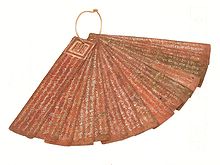 Isdhoo Lōmāfānu is the oldest copper-plate book to have been discovered in the Maldives to date. The book was written in AD 1194 (590 AH) in the Evēla form of the Divehi akuru, during the reign of Siri Fennaadheettha Mahaa Radun (Dhinei Kalaminja).
Isdhoo Lōmāfānu is the oldest copper-plate book to have been discovered in the Maldives to date. The book was written in AD 1194 (590 AH) in the Evēla form of the Divehi akuru, during the reign of Siri Fennaadheettha Mahaa Radun (Dhinei Kalaminja).
In the early 11th century, the Minicoy and Thiladhunmathi, and possibly other northern Atolls, were conquered by the medieval Chola Tamil emperor Raja Raja Chola I, thus becoming a part of the Chola Empire.
According to a legend from the Maldivian Folklore, in the early 12th century AD a medieval prince named Koimala nobleman of the Lion Race from Sri Lanka, sailed to Rasgetheemu island (literally Town of the Royal House or figuratively King's Town) in North Maalhosmadulu Atoll and from there to Malé and established a kingdom. By then, the Aadeetta (Sun) Dynasty (Suryavanshi ruling cast) had for some time ceased to rule in Malé, possibly because of invasions by the Cholas of Southern India in the Tenth Century. Koimala Kalou (Lord Koimala), who reigned as King Maanaabarana, was a king of the Homa (Lunar) Dynasty (Chandravanshi ruling cast), which some historians call the House of Theemuge. The Homa (Lunar) dynasty sovereigns inter-married with the Aaditta (Sun) Dynasty. This was why the formal titles of Maldive kings until 1968 contained references to "kula sudha ira" which means "descended from the Moon and the Sun". No official record exists of the Aadeetta dynasty's reign. Since Koimala's reign, the Maldive throne was also known as the Singaasana (Lion Throne).[37] Before then, and in some situations since, it was also known as the Saridhaaleys (Ivory Throne).[38] Some Historians credit Koimala of freeing the Maldives from Tamil Chola rule.
Several foreign travellers, mainly Arabs, had written about a kingdom of the Maldives ruled over by a queen. This kingdom pre-dated Koimala's reign. al-Idrisi, referring to the writings of earlier writers, mentions the name of one of the queens, Damahaar, who was a member of the Aadeetta (Sun) dynasty.
The conversion to Islam is mentioned in the ancient edicts written in copper plates from the end of the 12th century AD. There is also a locally well-known legend about a foreign saint (an Azeri from the city of Tabriz) who subdued a demon known as Rannamaari. Dhovemi Kalaminja who succeeded Koimala converted to Islam in the year AD 1153.
Over the centuries, the islands have been visited and their development influenced by sailors and traders from countries on the Arabian Sea and the Bay of Bengal. The main export of medieval Maldivians was cowrie shell, which they cultivated by floating branches of coconut palms in the sea, to which the shells attached themselves.[citation needed]
The Maldives were the first landfall for traders from Basrah, sailing to Sri Lanka or Southeast Asia. In the Maldives, ships could take on fresh water, fruit and the delicious, basket-smoked red flesh of the black bonito, a delicacy exported to Sindh and China and Yemen. The people of the archipelago were gentle, civilised and hospitable. They produced brass utensils as well as fine cotton textiles, exported in the form of sarongs and turban lengths. These local industries must have depended on imported raw materials.
The other essential product of the Maldives was coir, the fibre of the dried coconut husk. Cured in pits, beaten, spun and then twisted into cordage and ropes, coir's salient quality is its resistance to saltwater. It stitched together and rigged the Dhows that plied the Indian Ocean. Maldivian coir was exported to Sindh, China, Yemen and the Persian Gulf.
"It is stronger than hemp," wrote Ibn Battuta, "and is used to sew together the planks of Sindhi and Yemeni Dhows, for this sea abounds in reefs, and if the planks were fastened with iron nails, they would break into pieces when the vessel hit a rock. The coir gives the boat greater elasticity, so that it doesn't break up."
Colonial Period, Independence, Republic
Although governed as an independent Islamic sultanate from 1153 to 1968, the Maldives was a British protectorate from 1887 until 25 July 1965. On 16 December 1887, the Sultan of the Maldives signed a contract with the British Governor of Ceylon turning the Maldives into a British protected state, losing her sovereignty in matters of foreign policy. The British government promised military protection and non-interference in local administration in exchange for an annual tribute. In 1957 the British established an air base in the strategic southernmost atoll of Addu, paying £2000 a year, employing hundreds of locals. 19 years later, the British government gave up the base, as it was too expensive to maintain.[citation needed]
In 1953, there was an abortive attempt to form a republic, but the sultanate was re-imposed. In 1959, objecting to Nasir's centralism, the inhabitants of the three southernmost atolls protested against the government. They formed the United Suvadive Republic and elected Abdullah Afeef as president and Hithadhoo as capital of this republic.[citation needed]
The agreement giving the Maldives full political independence was signed on behalf of His Majesty the Sultan by Ibrahim Nasir Rannabandeyri Kilegefan, Prime Minister; and on behalf of Her Majesty the Queen by Sir Michael Walker, British Ambassador designate to the Maldive Islands. The Ceremony took place at the British High Commissioner's Residence in Colombo on 26 July 1965. After independence the sultanate continued to operate for another three years under King Muhammad Fareed Didi. On 11 November 1968, the monarchy was replaced by a republic under the presidency of Ibrahim Nasir, although this was a cosmetic change without any significant alteration in the structures of government. The official name of the country was changed from Maldive Islands to the Maldives. Tourism began to be developed on the archipelago by the beginning of the 1970s. The first accurate census was held in December 1977 and showed 142,832 persons residing in Maldives.[39]
However, political infighting during the '70s between Nasir's faction and other political figures led to the 1975 arrest and exile of elected prime minister Ahmed Zaki to a remote atoll. Economic decline followed the closure of the British airfield at Gan and the collapse of the market for dried fish, an important export. With support for his administration faltering, Nasir fled to Singapore in 1978, with millions of dollars from the treasury.
Maumoon Abdul Gayoom began his 30-year role as President in 1978, winning six consecutive elections without opposition. His election was seen as ushering in a period of political stability and economic development in view of Gayoom's priority to develop the poorer islands. Tourism flourished and increased foreign contact spurred development. However, Gayoom's rule was controversial, with some critics saying Gayoom was an autocrat who quelled dissent by limiting freedoms and political favoritism.[40]
A series of coup attempts (in 1980, 1983, and 1988) by Nasir supporters and business interests tried to topple the government without success. While the first two attempts met with little success, the 1988 coup attempt involved a roughly 200-person mercenary force of the PLOTE Tamil militant group who seized the airport and caused Gayoom to flee from house to house until the intervention of 1600 Indian troops airlifted into Malé restored order. The November 1988 coup was headed by Muhammadu Ibrahim Lutfee, a small businessman,. On the night of 3 November 1988, the Indian Air Force airlifted a parachute battalion group from Agra and flew them over 2,000 kilometres (1,200 mi) to the Maldives. The Indian paratroopers landed at Hulule and secured the airfield and restored the government rule at Malé within hours. The brief, bloodless operation, labelled Operation Cactus, also involved the Indian Navy.
2004 tsunami
 People in Malé removing sand bags from a nearby construction site, to be used as a barrier to protect their homes from the flood, shortly after being hit by the tsunami generated by the 2004 Indian Ocean earthquake
People in Malé removing sand bags from a nearby construction site, to be used as a barrier to protect their homes from the flood, shortly after being hit by the tsunami generated by the 2004 Indian Ocean earthquake
On 26 December 2004, following the 2004 Indian Ocean earthquake, the Maldives were devastated by a tsunami. Only nine islands were reported to have escaped any flooding,[41][42] while fifty-seven islands faced serious damage to critical infrastructure, fourteen islands had to be totally evacuated, and six islands were destroyed. A further twenty-one resort islands were forced to close because of serious damage. The total damage was estimated at more than US$400 million, or some 62 percent of the GDP.[43][44] A total of 108 people, including six foreigners, reportedly died in the tsunami.[40] The destructive impact of the waves on the low-lying islands was mitigated by the fact there was no continental shelf or land mass upon which the waves could gain height. The tallest waves were reported to be 14 feet (4.3 m) high.[45]
Government
Main article: Politics of the Maldives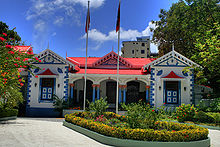 Muliaa'ge: the Presidential Palace of Malé, Maldives
Muliaa'ge: the Presidential Palace of Malé, Maldives
Maldives is a presidential republic, with the President as head of government and head of state. The President heads the executive branch and appoints the cabinet which is approved by the People's Majlis (Parliament). Following the introduction of a new constitution in 2008, direct elections for the President take place every five years, with a limit of two terms in office for any individual. The current President is Mohamed Nasheed. Members of the unicameral Majlis serve five-year terms, with the total number of members determined by atoll populations. At the 2009 election, 77 members were elected.
Prior to 2008, Maldives did not have a constitution which guaranteed fundamental human rights. For 30 years, from 1978 until 2008, Maumoon Abdul Gayoom served as president. During the later part of his rule, independent political movements emerged in Maldives, which challenged the then-ruling Dhivehi Rayyithunge Party (Maldivian People's Party) and demanded democratic reform. These movements brought about significant change in political structure. In 2008 a new constitution was approved and the first direct presidential elections occurred, which were won by Mohamed Nasheed and Dr. Mohammed Waheed Hassan (as Vice-President) in the second round. The 2009 parliamentary election saw the Maldivian Democratic Party of President Nasheed receive the most votes with 30.81%, gaining 26 seats, however the Dhivehi Rayyithunge Party with 24.62% of the vote received the most seats (28).
Despite the passage from monarchy to republic, the contemporary political structure shows continuity in which power was shared among a few families at the top of the social structure. In some islands, the offices have remained within the same family for generations. In the modern day, the village is ruled by an administrative officer called Katību, who serves as the executive headman of the island. Above the Katībus of every atoll is the AtoỊuveriya (Atoll Chief). Although many islands are distant from the governing capital, administrative rights over the lawmaking body of a particular island is held to a minimum, hence centralizing representatives from islands to a general parliament. The People's Majlis, located in Male, houses members from all over the country.[46]
Challenges
The government of President Mohamed Nasheedh faced many challenges, including the economic downturn following the 2004 tsunami, overspending (by means of overprinting of local currency Ruffiya) during his regime, global warming, unemployment, corruption, and increasing drug use. On 10 November 2008, Nasheed announced an intent to create a sovereign wealth fund with money earned from tourism that could be used to purchase land elsewhere for the Maldives people to relocate should rising sea levels due to climate change inundate the country. The government is reportedly considering locations in Sri Lanka and India due to cultural and climate similarities, and as far away as Australia.[40]
Administrative divisions
Main article: Administrative divisions of the Maldives Each administrative atoll is marked, along with the thaana letter used to identify the atoll. Natural atolls are labelled in light blue. Full view of the map
Each administrative atoll is marked, along with the thaana letter used to identify the atoll. Natural atolls are labelled in light blue. Full view of the map
The Maldives has 7 provinces each consisting of the following administrative divisions (the capital Malé is its own administrative division):
- Mathi-Uthuru Province; consists of Haa Alif Atoll, Haa Dhaalu Atoll and Shaviyani Atoll.
- Uthuru Province; consists of Noonu Atoll, Raa Atoll, Baa Atoll and Lhaviyani Atoll.
- Medhu-Uthuru Province; consists of Kaafu Atoll, Alifu Alifu Atoll, Alifu Dhaalu Atoll and Vaavu Atoll.
- Medu Province; consists of Meemu Atoll, Faafu Atoll and Dhaalu Atoll.
- Medhu-Dhekunu Province; consists of Thaa Atoll and Laamu Atoll.
- Mathi-Dhekunu Province; consists of Gaafu Alifu Atoll and Gaafu Dhaalu Atoll.
- Dhekunu Province; consists of Gnaviyani Atoll and Addu City.
These provinces correspond to the historic divisions of Uthuru Boduthiladhunmathi. Dhekunu Boduthiladhunmathi, Uthuru Medhu-Raajje, Medhu-Raajje, Dhekunu Medhu-Raajje, Huvadhu (or Uthuru Suvadinmathi) and Addumulah (or Dhekunu Suvadinmathi).
The Maldives has twenty-six natural atolls and few island groups on isolated reefs, all of which have been divided into twenty-one administrative divisions (twenty administrative atolls and Malé city).[47]
In addition to a name, every administrative division is identified by the Maldivian code letters, such as "Haa Alif" for Thiladhunmati Uthuruburi (Thiladhunmathi North); and by a Latin code letter.
The first corresponds to the geographical Maldivian name of the atoll. The second is a code adopted for convenience. It began in order to facilitate radio communication between the atolls and the central administration. As there are certain islands in different atolls that have the same name, for administrative purposes this code is quoted before the name of the island, for example: Baa Funadhoo, Kaafu Funadhoo, Gaafu-Alifu Funadhoo. Since most Atolls have very long geographical names it is also used whenever the long name is inconvenient, for example in the atoll website names.[48]
This code denomination has been very much abused by foreigners who did not understand the proper use of these names and have ignored the Maldivian true names in publications for tourists.[49] Maldivians may use the letter code name in colloquial conversation, but in serious geographic, historical or cultural writings, the true geographical name always takes precedence. The Latin code letter is normally used in boat registration plates. The letter stands for the atoll and the number for the island.
Each atoll is administered by an Atoll Chief (Atholhu Veriyaa) appointed by the President. The Ministry of Atoll Administration and its Northern and Southern Regional Offices, Atoll Offices and Island Offices are collectively responsible to the President for Atolls Administration. The administrative head of each island is the Island Chief (Katheeb), appointed by the President. The Island Chief's immediate superior is the Atoll Chief.
The introduction of code-letter names has been a source of much puzzlement and misunderstandings, especially among foreigners. Many people have come to think that the code-letter of the administrative atoll is its new name and that it has replaced its geographical name. Under such circumstances it is hard to know which is the correct name to use.[48]
As a Republic the Constitution came into force in 1968 (and was amended in 1970, 1972, and 1975.) On 27 November 1997 was replaced by another Constitution assented to by the President Gayoom. This Constitution came into force on 1 January 1998. All stated that the president was the Head of State, Head of Government and the Commander-in-Chief of the Armed Forces and the Police of the Maldives. A third Constitution was ratified on 7 August 2008, which separated the judiciary from the head of state.
Judiciary
See also: Judiciary in the MaldivesAccording to the Constitution of Maldives, "The judges are independent, and subject only to the constitution and the law. When deciding matters on which the Constitution or the law is silent, judges must consider Islamic Shari'ah."
The independent Judicial Services Commission is the core of the judiciary. It oversees the appointment and dismissal of judges, and acts as a 'watchdog' to ensure that Judges uphold the code of conduct. Currently in an interim stage, one member is appointed by the president others come from the Civil Service Commission, parliament, the public, high court judge, lower court judge and a supreme court member. Including a supreme court member presents a conflict of interest given that the Supreme Court must be composed with the advice of the commission.
There has been raised concerns over the independence of the commission, given that of eight interim members, the President appoints one and all current judges were appointed by President Gayoom under the previous constitution, of whom two were appointed to the commission.
The Supreme Court of Maldives is headed by a Chief Justice, who is the head of judiciary. As of 2008 the President had appointed 5 judges, who were approved by the Parliament. The interim court will sit until a new permanent Supreme Court is nominated under the constitution. Underneath the Supreme Court sit a High Court and a Trial court. The constitution requires an odd number of judges in the High Court of Maldives, leading to the current three appointed justices. Verdicts must be reached by a majority, but must also include a minority report.
An appointed Prosecutor General is responsible for initiating court proceedings on behalf of the government, oversees how investigations are being conducted and has a say in criminal prosecutions, duties previously held by the Attorney General. The Prosecutor General has the power to order investigations, monitor detentions, lodge appeals and review existing cases. The Prosecutor General is appointed by the President and has to be approved by the Parliament.
The Maldives, in cooperation with the United Nations Development Programme (UNDP), wrote the world's first Islamic criminal code. As of 2008 the code awaited action by the parliament.
Military
Main article: Maldives National Defence ForceThe Maldives National Defense Force (MNDF) is a combined security force responsible for defending the security and sovereignty of the Maldives, having the primary task of being responsible for attending to all internal and external security needs of the Maldives, including the protection of the Exclusive Economic Zone (EEZ).
The MNDF component branches are the Coast Guard, the Fire & Rescue Service, Infantry Services, Defence Institute for Training & Education (Training Command), and Support Services.
Coast Guard
As a water-bound nation much of the security concerns lie at sea. Almost 99% of the country is covered by sea and the remaining 1% land is scattered over an area of 800 km (497 mi) x 120 km (75 mi), with the largest island being not more than 8 km2 (3 sq mi). Therefore the duties assigned to the MNDF of maintaining surveillance over Maldives' waters and providing protection against foreign intruders poaching in the EEZ and territorial waters, are immense tasks from both logistical and economic view points. Hence, for carrying out these functions, it is the Coast Guard that plays a vital role. To provide timely security its patrol boats are stationed at various MNDF Regional Headquarters.
Coast Guard is also assigned to respond to the maritime distress calls and to conduct search and rescue operations in a timely manner. Maritime pollution control exercises are conducted regularly on an annual basis for familiarization and handling of such hazardous situations.
Coast Guards also undertake armed sea transport of troops and military equipment around the country.
Demographics
Main article: Demographics of the Maldives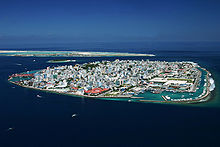 Malé, the capital of the Maldives
Malé, the capital of the Maldives
The Maldivian ethnic identity is a blend of the cultures reflecting the peoples who settled on the islands, reinforced by religion and language. The earliest settlers were probably from southern India and Sri Lanka. They are linguistically and ethnically related to the people in the Indian subcontinent. They are ethnically known as Dhivehis.
Some social stratification exists on the islands. It is not rigid, since rank is based on varied factors, including occupation, wealth, Islamic virtue, and family ties. Traditionally, instead of a complex caste system, there was merely a distinction between noble (bēfulhu) and common people in the Maldives. Members of the social elite are concentrated in Malé.
A census has been recorded since 1905, which shows that the population of the country remained around 100,000 for the following sixty years. Following independence in 1965, the rate of population growth rose due to improving health. The population doubled by 1978, and the population growth rate peaked at 3.4% in 1985. By 2007, the population had reached 300,000, although the census in 2000 showed that the population growth rate had declined to 1.9%. Life expectancy at birth stood at 46 years in 1978, and later rose to 72. Infant mortality has declined from 127 per thousand in 1977 to 12 per thousand today, and adult literacy reached 99%. Combined school enrollment reached the high 90s.
As of April 2008, more than 70,000 foreign employees lived in the country and another 33,000 illegal immigrants comprised more than one third of Maldivian population. They consisted mainly of people from the neighboring South Asian countries of India, Sri Lanka, Bangladesh and Nepal.
Economy
Main article: Economy of the Maldives Various plants were submerged into the sea in order to attract large sea snails, nautiluses, gastropods and mollusks. Their valuable cowrie shells were sold throughout the Medieval world. Picture: Cypraea Guttata Surinensis, called The Great spotted cypraea found in the Maldives
Various plants were submerged into the sea in order to attract large sea snails, nautiluses, gastropods and mollusks. Their valuable cowrie shells were sold throughout the Medieval world. Picture: Cypraea Guttata Surinensis, called The Great spotted cypraea found in the Maldives
In ancient times the Maldives were renowned for cowry shells, coir rope, dried tuna fish (Maldive Fish), ambergris (Maavaharu) and coco de mer (Tavakkaashi). Local and foreign trading ships used to load these products in Sri Lanka and transport them to other harbors in the Indian Ocean.
Historically Maldives provided enormous quantities of cowry shells, an international currency of the early ages. From the 2nd century AD the islands were known as the 'Money Isles' by the Arabs.[50] Monetaria moneta were used for centuries as a currency in Africa, and huge amounts of Maldivian cowries were introduced into Africa by western nations during the period of slave trade.[51] The cowry is now the symbol of the Maldives Monetary Authority.
The Maldivian government began an economic reform program in 1989, initially by lifting import quotas and opening some exports to the private sector. Subsequently, it has liberalized regulations to allow more foreign investment. Real GDP growth averaged over 7.5% per year for more than a decade. Today, the Maldives' largest industry is tourism, accounting for 28% of GDP and more than 60% of the Maldives' foreign exchange receipts. Fishing is the second leading sector.[52]
The Maldivian economy is to a large degree based on tourism. In late December 2004, the major tsunami left more than 100 dead, 12,000 displaced, and property damage exceeding $400 million. As a result of the tsunami, the GDP contracted by about 3.6% in 2005. A rebound in tourism, post-tsunami reconstruction, and development of new resorts helped the economy recover quickly and showed an 18% increase on 2006. 2007 estimates show Maldivians enjoy the highest GDP per capita $4,600 (2007 est) among south Asian countries.
Tourism
Main articles: Tourism in the Maldives and Diving in the MaldivesMaldives was largely terra incognita for tourists until the early 1970s. Only 185 islands are home to its 300,000 population, while the other islands are used entirely for economic purposes of which tourism and agriculture are the most dominant. Tourism accounts for 28% of GDP and more than 60% of the Maldives' foreign exchange receipts. Over 90% of government tax revenue comes from import duties and tourism-related taxes.[53] The development of tourism fostered the overall growth of the country's economy. It created direct and indirect employment and income generation opportunities in other related industries. The first tourist resorts were opened in 1972 with Bandos island resort and Kurumba Village.[citation needed]
Maldivian beach video
According to the Ministry of Tourism, the emergence of tourism in 1972 transformed the economy, moving rapidly from dependence on fisheries to tourism. In just three and a half decades, the industry became the main source of income. Tourism was also the country's biggest foreign currency earner and the single largest contributor to the GDP. As of 2008, 89 resorts in the Maldives offered over 17,000 beds and hosted over 600,000 tourists annually.[54]
The number of resorts increased from 2 to 92 between 1972 and 2007. As of 2007, over 8,380,000 tourists had visited Maldives.[55]
Most visitors arrived at Malé International Airport, on Hulhulé Island, adjacent to the capital Malé. The airport is served by flights to India, Sri Lanka, Doha, Dubai, Singapore and major airports in South-East Asia, as well as of charters from Europe. Gan Airport, on the southern atoll of Addu, also serves an international flight to Milan several times a week.
Outside the service industry, Male is the only location where the foreign and domestic populations are likely to interact. The tourist resorts are not on islands where the natives live, and casual contacts between the two groups are discouraged.[citation needed]
Fishing industry
Main article: Fishing industry in the Maldives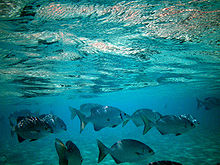 Maldives rudderfish (Kyphosus cinerascens)
Maldives rudderfish (Kyphosus cinerascens)
For many centuries the Maldivian economy was entirely dependent on fishing and other marine products. Fishing remains the main occupation of the people and the government gives priority to the fisheries sector.
The mechanization of the traditional fishing boat called dhoni in 1974 was a major milestone in the development of the fisheries industry. A fish canning plant was installed on Felivaru in 1977, as a joint venture with a Japanese firm. In 1979, a Fisheries Advisory Board was set up with the mandate of advising the government on policy guidelines for the overall development of the fisheries sector. Manpower development programs began in the early 1980s, and fisheries education was incorporated into the school curriculum. Fish aggregating devices and navigational aids were located at various strategic points. Moreover, the opening up of the Exclusive Economic Zone (EEZ) of the Maldives for fisheries has further enhanced the growth of the fisheries sector.
As of 2010, fisheries contributed over fifteen percent of the country's GDP and engaged about thirty percent of the country's work force. Fisheries were also the second-largest foreign exchange earner after tourism.
Agriculture and Cottage industries
Agriculture and manufacturing continue to play a lesser role in the economy, constrained by the limited availability of cultivable land and the shortage of domestic labor. Most staple foods must be imported. Industry, which consists mainly of garment production, boat building, and handicrafts, accounts for about 7% of GDP.[citation needed] Tourism gave a major boost to the country's fledgling traditional cottage industries such as mat weaving, lacquer work, handicraft, and coir rope making. New industries that have since emerged include printing, production of PVC pipes, brick making, marine engine repairs, bottling of aerated water, and garment production.
Religion
See also: Freedom of religion in the Maldives and Irreligion in the MaldivesIslam is the official religion of The Maldives. Maldives is a 99.41% Muslim country although open practice of all other religions is forbidden and such actions are liable to prosecution. Article 2 of the revised constitution says that the republic "is based on the principles of Islam." Article nine says that "a non-Muslim may not become a citizen"; Article ten says that "no law contrary to any principle of Islam can be applied" Article nineteen states that "citizens are free to participate in or carry out any activity that is not expressly prohibited by sharia or by the law."
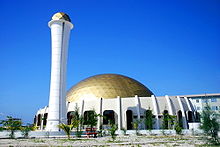 Mosque in Hulhumalé
Mosque in Hulhumalé
The requirement to adhere to a particular religion and prohibition of public worship following other religions is contrary to Article 18 of the Universal Declaration of Human Rights and Article 18 of the International Covenant on Civil and Political Rights to which Maldives has recently become party[56] and was addressed in Maldives' reservation in adhering to the Covenant claiming that "The application of the principles set out in Article 18 of the Covenant shall be without prejudice to the Constitution of the Republic of the Maldives."[57]
The Maldives ranks high on the list of governments that restrict religious freedom.
The Indian Ocean Commission
 Satellite image of the Maldives by NASA.
Satellite image of the Maldives by NASA.
Since 1996, the Maldives has been the official progress monitor of the Indian Ocean Commission. In 2002, the Maldives began to express interest in the Commission but as of 2008 had not applied for membership. Maldive's interest relates to its identity as a small island state, especially economic development and environmental preservation, and its desire for closer relations with France, a main actor in the IOC region. The Maldives is a founding member of the South Asian Association for Regional Cooperation, SAARC, and as former protectorate of Great Britain, joined the Commonwealth in 1982, some 17 years after gaining independence from Great Britain. The Maldives enjoys close ties with Commonwealth members Seychelles and Mauritius. The Maldives and Comoros are also both members of the Organisation of Islamic Cooperation. The Maldives has refused to negotiate with Mauritius over the demarcation of the maritime border between the Maldives and the British Indian Ocean Territory, instead continuing discussions with the United Kingdom, who under international law, retains sovereignty of the Chagos Archipelago.
Language and culture
Main article: Culture of the MaldivesSee also: Dhivehi language, Dhivehi writing systems, Islam in the Maldives, Music of the Maldives, and Maldivian Folklore Pre-Islamic Buddhist Stupa of Maldives, excavated in Thoddoo in the 1950s
Pre-Islamic Buddhist Stupa of Maldives, excavated in Thoddoo in the 1950s
Maldivian culture is heavily influenced by geographical proximity to Sri Lanka and southern India.
The official and common language is Dhivehi, an Indo-European language having some similarities with Elu, the ancient Sinhalese language. The first known script used to write Dhivehi is Eveyla akuru script which is found in historical recording of kings (raadhavalhi). Later a script called Dhives akuru was used for a long period. The present-day script is called Thaana and is written from right to left. Thaana is said to have been introduced by the reign of Mohamed Thakurufaanu. English is used widely in commerce and increasingly in government schools.
The language is of Indic Sanskritic origin, which points at a later influence from the north of the subcontinent. According to the legends, the kingly dynasty that ruled the country in the past had its origin there.
The Islamic Centre, housing the mosque Masjid-al-Sultan Mohammed Thakurufaanu-al-A'z'am
After the long Buddhist[58] period of Maldivian history, Muslim traders introduced Sunni Islam. Maldivians converted to Islam by the mid-12th century. The island has a long history of Sufic orders, as can be seen in the history of the country such as the building of tombs. They were used until as recent as the 1980s for seeking the help of buried Saints. They can be seen today next to some old mosques and are considered today as cultural heritage. Other aspects of tassawuf, such as ritualized dhikr ceremonies called Maulūdu (Mawlid)—the liturgy of which included recitations and certain supplications in a melodical tone—existed until very recent times. These Maulūdu festivals were held in ornate tents specially built for the occasion. At present Sunni Islam is the official religion of the entire population, as adherence to it is required for citizenship.
Since the 12th century AD there were also influences from Arabia in the language and culture of the Maldives because of the conversion to Islam and its location as a crossroads in the central Indian Ocean. This was due to the long trading history between the far east and the middle east. Somali travelers discovered the island for gold in the 13th Century, before the Portuguese. Their brief stay later ended in a bloody conflict known by the Somalis as "Dagaal Diig Badaaney" in 1424.
According to Moroccan traveler Ibn Battuta, the person responsible for this conversion was a Sunni Muslim visitor named Abu al Barakat sailing from Morocco. However, more reliable Maldivian tradition says that he was a Persian saint from Tabriz called Yusuf Shamsuddin. He is also referred to as Tabrizugefaanu. His venerated tomb now stands on the grounds of the Friday Mosque, or Hukuru miskiy, in Malé. Built in 1656, this is the country's oldest mosque.
Maldives' Firsts
- Set a record in 2006 for the largest number of scuba divers participating in one dive, with a grand total of 958 divers descending into the water at the same time. This record was broken by Indonesia in 2009.
- Opened the first virtual embassy, in the online world Second Life, on 22 May 2007.[59][60]
- Held the first cabinet meeting underwater. The meeting was chaired by President Mohamed Nasheed. In the meeting, the President, Vice President, and the cabinet signed a declaration calling for concerted global action on climate change, ahead of the UN climate conference in Copenhagen. The underwater meeting was part of a wider campaign by international environmental NGO 350.org.[61]
See also
- Outline of Maldives
- Index of Maldives-related articles
- Commonwealth of Nations
- Ibn Battuta in the Maldives
References
- ^ David Levinson (1947). Ethnic groups worldwide: a ready reference handbook. Oryx Publishers. http://books.google.mv/books?id=uwi-rv3VV6cC&q=maldives. Retrieved 2011-02-01.
- ^ http://www.iias.nl/iiasn/iiasn5/insouasi/maloney.html
- ^ http://www.maldives-ethnography.com/
- ^ "Constitutional disaster averted as Parliament approves Supreme Court". Minivannews.com. http://minivannews.com/politics/constitutional-disaster-averted-as-parliament-approves-supreme-court-10233. Retrieved 2010-12-30.
- ^ a b "Data: Maldives". World Bank. http://data.worldbank.org/country/maldives. Retrieved 1 September 2011.
- ^ "TABLE PP 1: CENSUS POPULATION BY SEX, SEX - RATIO AND INTER-CENSAL VARIATION OF POPULATION, 1911 - 2006". Planning.gov.mv. http://www.planning.gov.mv/publications/census2006_island_level_tables/population/population/PP_01.htm. Retrieved 2010-12-30.
- ^ a b c d "Maldives". International Monetary Fund. http://www.imf.org/external/pubs/ft/weo/2011/01/weodata/weorept.aspx?sy=2008&ey=2011&scsm=1&ssd=1&sort=country&ds=.&br=1&c=556&s=NGDPD%2CNGDPDPC%2CPPPGDP%2CPPPPC%2CLP&grp=0&a=&pr.x=36&pr.y=9. Retrieved 2011-04-21.
- ^ "Human Development Report 2009. Human development index trends: Table G". The United Nations. http://hdr.undp.org/en/media/HDR_2009_EN_Complete.pdf. Retrieved 2009-10-05.
- ^ http://www.nationalgeographic.com/wildworld/profiles/terrestrial/im/im0125.html
- ^ "Terrestrial Ecoregions - Maldives-Lakshadweep-Chagos Archipelago tropical moist forests (IM0125)". Nationalgeographic.com. http://www.nationalgeographic.com/wildworld/profiles/terrestrial/im/im0125.html. Retrieved 2010-12-30.
- ^ "Lets learn more about Maldives Island". Smartmaldives.com. http://www.smartmaldives.com/maldives-island.html. Retrieved 2010-06-30.
- ^ "Table 3.3 Population by Atoll". Department of National Planning. http://planning.gov.mv/yearbook2009/Populations/3.3.htm. Retrieved 1 September 2011.
- ^ a b Henley, Jon (11 November 2008). "The last days of paradise". The Guardian (London). http://www.guardian.co.uk/environment/2008/nov/11/climatechange-endangered-habitats-maldives. Retrieved 12 May 2010.
- ^ Hogendorn, J.; Johnson, M. The Shell Money of the Slave Trade, pp. 20–22.
- ^ Apte, Vaman Shivram (1985). Sanskrit-English Dictionary. Motilal Banarsidass, New Delhi, 1985.
- ^ Ibn Batuta Travels in Asia and Africa. translated by A. R. Gibb.
- ^ Akhbar al-Sin wa 'l-Hind (Notes on China and India), which dates from 851.
- ^ Lunde, Paul. The Seas of Sinbad, Saudi Aramco World Magazine, Vol. 56, No. 4.
- ^ "Entire Maldives cabinet resigns – CENTRAL/S. ASIA". Al Jazeera English. http://english.aljazeera.net/news/asia/2010/06/201062915490741700.html. Retrieved 2010-06-30.
- ^ "Maldives - Atlapedia Online". http://www.atlapedia.com/online/countries/maldives.htm.
- ^ Bruce C. Douglas (1997). "Global Sea Rise: A Redetermination". Surveys in Geophysics 18: 279–292. doi:10.1023/A:1006544227856.
- ^ "A 20th century acceleration in global sea-level rise". Agu.org. 2006-01-06. http://www.agu.org/pubs/crossref/2006/2005GL024826.shtml. Retrieved 2010-06-30.
- ^ Mörner N.-A.; Tooley M., Possnert, G (2003-05-07). "New Perspectives for the future of the Maldives" (PDF). http://stephenschneider.stanford.edu/Publications/PDF_Papers/MornerEtAl2004.pdf.
- ^ Ramesh, Randeep (10 November 2008). "Paradise almost lost: Maldives seek to buy a new homeland". The Guardian (London). http://www.guardian.co.uk/environment/2008/nov/10/maldives-climate-change. Retrieved 12 May 2010.
- ^ Randeep Ramesh in Male (2008-11-10). "Paradise almost lost: Maldives seek to buy a new homeland". London: The Guardian. http://www.guardian.co.uk/environment/2008/nov/10/maldives-climate-change. Retrieved 2010-06-30.
- ^ (AFP) – Apr 22, "awareness of threats from climate change to low-lying nations such as the Maldives."
- ^ Lang, Olivia (17 October 2009). "Maldives leader in climate change stunt". BBC News. http://news.bbc.co.uk/2/hi/south_asia/8312320.stm. Retrieved 2010-10-19.
- ^ "Climate Change Gridlock: Where Do We Go From Here? (Part 1)". Making Contact. National Radio Project. 28 June 2011. http://www.radioproject.org/2011/06/climate-change-gridlock-where-do-we-go-from-here-part-1/. Retrieved 30 June 2011.
- ^ a b Hoon, V., Chong, K.-C., Roy, R., Bierhuizen, B., & Kanvinde, J. R. (1997). Regional Workshop on the Conservation and Sustainable Management of Coral Reefs. Project reports, 1.
- ^ a b Maldives Marine Life. Retrieved June 11, 2010.
- ^ a b Wheatley, A. (2004). "Maldives Nurses Its Coral Reefs Back to Life". Global Coral Reef Alliance. Retrieved June 11, 2010.
- ^ Williams, E., and Bunkley-Williams, L. (1990). The Worldwide Coral Reef Bleaching Cycle and Related Sources of Coral Mortality. Washington, D.C, U.S.: National Museum of Natural History Smithsonian Institution.
- ^ "Marine Life of the Maldives" (n.d.). Retrieved June 10, 2010.
- ^ Xavier Romero-Frias, The Maldive Islanders, A Study of the Popular Culture of an Ancient Ocean Kingdom
- ^ a b Maloney, Clarence. "Maldives People". http://www.iias.nl/iiasn/iiasn5/insouasi/maloney.html. Retrieved 2008-06-22.
- ^ Philostorgius, Church History, tr. Amidon, pp.41-44; Philostorgius' history survives in fragments, and he wrote some 75 years later than these events.
- ^ "Maldives Royal Family". http://www.maldivesroyalfamily.com/maldives_proclamation_sultan.shtml.
- ^ "Maldives Royal Family". http://www.maldivesroyalfamily.com/maldives_koimala.shtml.
- ^ "Maldives - Population". Library of Congress Country Studies.
- ^ a b c CNN (11 November 2008). "Sinking island nation seeks new home". http://www.cnn.com/2008/WORLD/asiapcf/11/11/maldives.president/index.html. Retrieved 2008-11-12.BAT
- ^ "Maldives - Country Review Report on the Implementation of the Brussels Programme of Action for LDCS". http://www.un.org/special-rep/ohrlls/ldc/MTR/Maldives.pdf.
- ^ "Maldives Skyscraper – Floating States". http://www.evolo.us/architecture/maldives-skyscraper-floating-states/.
- ^ "UNDP: Discussion Paper - Achieving Debt Sustainability and the MDGs in Small Island Developing States: The Case of the Maldives". http://undp.org.mv/v2/publication_files/4d3d53b1f2a35.pdf.
- ^ "Maldives tsunami damage 62 percent of GDP: WB". http://www.chinadaily.com.cn/english/doc/2005-02/15/content_416614.htm.
- ^ "Republic of Maldives - Tsunami: Impact and Recovery". http://www.undp.org.mv/v2/publication_files/4b36072ca065c.pdf.
- ^ "Maldives Enthongraphy". Maldives-ethnography.com. http://www.maldives-ethnography.com/. Retrieved 2010-06-30.
- ^ "Maldives Atolls<!- Bot generated title -> from". Statoids.com. http://www.statoids.com/umv.html. Retrieved 2010-06-30.
- ^ a b Divehiraajjege Jōgrafīge Vanavaru. Muhammadu Ibrahim Lutfee
- ^ Such as Thor Heyerdah's book The Maldive Mystery for example
- ^ James Lyon (2003-10). Maldives By James Lyon. Lonely Planet Publications Pty Ltd. pp. 9. http://books.google.com.my/books?id=hJD94VZweCIC&pg=PA9&lpg=PA9&dq=Money+Isles+maldives. Retrieved 2011-02-01.
- ^ Hogendorn, Jan and Johnson Marion: The Shell Money of the Slave Trade. African Studies Series 49, Cambridge University Press, Cambridge, 1986.
- ^ "Maldives travel guide". http://wikitravel.org/en/Maldives#Economy.
- ^ "Maldives travel guide". http://wikitravel.org/en/Maldives.
- ^ Ministry of Tourism. Retrieved 3 April 2009.
- ^ Report 'Fathuruverikamuge Tharaggeege Dhuveli, 35 Aharu' translated to english 'Pace of Tourism, 35 years'Ministry of Tourism and Civil Aviation, volume 23. http://tourism.gov.mv/pubs/35_years_of_tourism_final.pdf. Retrieved 3 April 2009.
- ^ "Ministry of Foreign Affairs, Maldives". Foreign.gov.mv. http://www.foreign.gov.mv/v3/?p=menu_item&sub_id=21&submenu=Human%20Rights%20and%20Democracy. Retrieved 2010-06-30.
- ^ "Powered by Google Docs". Docs.google.com. http://docs.google.com/gview?a=v&q=cache:vDo8t9r8544J:www.internat-recht.uni-kiel.de/veranstaltungen/lehrveranstaltungen/ss09/giegerich/vrII/materialien/PubIntLIIMaldives.pdf+maldives+%22international+covenant%22&hl=en&gl=us&sig=AFQjCNH5ZrO4bqRO0D_sET5MrodSBbxEpg. Retrieved 2010-06-30.
- ^ Conversion of the Maldives to Islam
- ^ Page, Jeremy (2007-05-27). "Tiny island nation opens the first real embassy in virtual world". The Times (London). http://technology.timesonline.co.uk/tol/news/tech_and_web/article1832158.ece.
- ^ "Maldives Unveils Worlds First Virtual Embassy" (Press release). Ministry of Foreign Affairs. 2007-05-22. http://www.foreign.gov.mv/v3/?p=news&view=sep&nid=123.
- ^ World’s first ever underwater cabinet meeting concludes in the Maldives
Further reading
- Divehiraajjege Jōgrafīge Vanavaru. Muhammadu Ibrahim Lutfee. G.Sōsanī. Malé 1999.
- H. C. P. Bell, The Maldive Islands, An account of the Physical Features, History, Inhabitants, Productions and Trade. Colombo 1883, ISBN 8120612221
- H.C.P. Bell, The Maldive Islands; Monograph on the History, Archaeology and Epigraphy. Reprint Colombo 1940. Council for Linguistic and Historical Research. Male' 1989
- H.C.P. Bell, Excerpta Maldiviana. Reprint Colombo 1922/35 edn. Asian Educational Services. New Delhi 1999
- Xavier Romero-Frias, The Maldive Islanders, A Study of the Popular Culture of an Ancient Ocean Kingdom. Barcelona 1999, ISBN 8472548015
- Divehi Tārīkhah Au Alikameh. Divehi Bahāi Tārikhah Khidmaiykurā Qaumī Markazu. Reprint 1958 edn. Malé 1990.
- Christopher, William 1836–38. Transactions of the Bombay Geographical Society, Vol. I. Bombay.
- Lieut. I.A. Young & W. Christopher, Memoirs on the Inhabitants of the Maldive Islands.
- Geiger, Wilhelm. Maldivian Linguistic Studies. Reprint 1919 edn. Asian Educational Services. Delhi 1999.
- Hockly, T.W. The Two Thousand Isles. Reprint 1835 edn. Asian Educational Services. Delhi 2003.
- Hideyuki Takahashi, Maldivian National Security –And the Threats of Mercenaries, The Round Table(London), No. 351, July 1999, pp. 433–444.
- Malten, Thomas: Malediven und Lakkadiven. Materialien zur Bibliographie der Atolle im Indischen Ozean. Beiträge zur Südasien-Forschung Südasien-Institut Universität Heidelberg, Nr. 87. Franz Steiner Verlag. Wiesbaden, 1983.
- Vilgon, Lars: Maldive and Minicoy Islands Bibliography with the Laccadive Islands. Published by the author. Stockholm, 1994.
External links
- Official Tourist Information
- Presidents Office
- Beautiful images of Maldives
- Maldives entry at The World Factbook
- Maldives at the Open Directory Project
- Wikimedia Atlas of Maldives
- Maldives travel guide from Wikitravel
Coordinates: 3°12′N 73°13′E / 3.20°N 73.22°E
 Maldives topics
Maldives topicsPolitics Constitution · President · Cabinet · Parliament · Elections · Political parties · Military · Emblem · Human rights (Freedom of religion · Irreligion · LGBT rights) · Foreign relations · Crime · Law enforcement · Judiciary · Administrative divisionsHistory Folklore · Koimala · Dynasties · Sultans · 1952 republic referendum · 1968 republic referendum · 2003 civil unrest · Black Friday · 2004 tsunami · 2005 civil unrest · Multi-party democracyGeography Economy Currency · Stock exchange · Industries · Fishing · Tourism · Communications · Transport · Airports · Economic aidSociety Demographics · Language · Writing scripts · Education · Music · Cuisine · Sports · Islam · Flag · AnthemCategories:- Maldives
- Archipelagoes of the Indian Ocean
- Countries of the Indian Ocean
- Island countries
- Islands of the Indian Ocean
- Member states of the Organisation of Islamic Cooperation
- Republics
- Member states of the South Asian Association for Regional Cooperation
- South Asian countries
- States and territories established in 1965
- Member states of the United Nations
Wikimedia Foundation. 2010.

